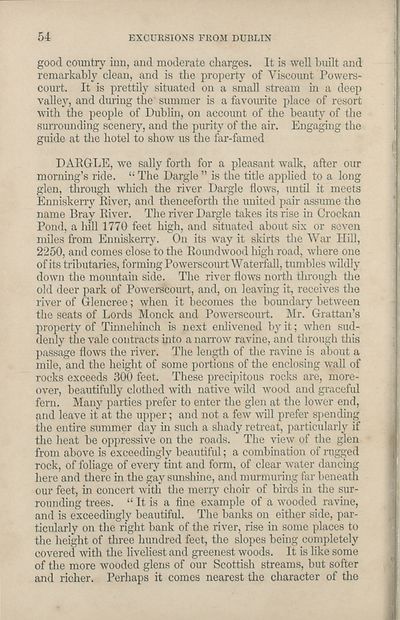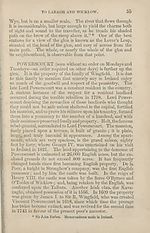Download files
Complete book:
Individual page:
Thumbnail gallery: Grid view | List view

54
EXCURSIONS FROM DUBLIN
good country inn, and moderate charges. It is well built and
remarkably clean, and is the property of Viscount Powers-
court. It is prettily situated on a small stream in a deep
valley, and during the summer is a favourite place of resort
with the people of Dublin, on account of the beauty of the
surrounding scenery, and the purity of the air. Engaging the
guide at the hotel to show us the far-famed
DARGLE, we sally forth for a pleasant walk, after our
morning’s ride. “ The Dargle ” is the title applied to a long
glen, through which the river Dargle flows, until it meets
Enniskerry River, and thenceforth the united pair assume the
name Bray River. The river Dargle takes its rise in Crockan
Pond, a hill 1770 feet high, and situated about six or seven
miles from Enniskerry. On its way it skirts the War Hill,
2250, and comes close to the Roundwood high road, where one
of its tributaries, forming Powerscourt Waterfall, tumbles wildly
down the mountain side. The river flows north through the
old deer park of Powerscourt, and, on leaving it, receives the
river of Glencree; when it becomes the boundary between
the seats of Lords Monck and Powerscourt. Mr. Grattan’s
property of Tinnehinch is next enlivened by it; when sud¬
denly the vale contracts into a narrow ravine, and through this
passage flows the river. The length of the ravine is about a
mile, and the height of some portions of the enclosing wall of
rocks exceeds 300 feet. These precipitous rocks are, more¬
over, beautifully clothed with native wild wood and graceful
fern. Many parties prefer to enter the glen at the lower end,
and leave it at the upper; and not a few will prefer spending
the entire summer day in such a shady retreat, particularly if
the heat be oppressive on the roads. The view of the glen
from above is exceedingly beautiful; a combination of rugged
rock, of foliage of every tint and form, of clear water dancing
here and there in the gay sunshine, and murmuring far beneath
our feet, in concert with the merry choir of birds in the sur¬
rounding trees. “ It is a fine example of a wooded ravine,
and is exceedingly beautiful. The banks on either side, par¬
ticularly on the right bank of the river, rise in some places to
the height of three hundred feet, the slopes being completely
covered with the liveliest and greenest woods. It is like some
of the more wooded glens of our Scottish streams, but softer
and richer. Perhaps it comes nearest the character of the
EXCURSIONS FROM DUBLIN
good country inn, and moderate charges. It is well built and
remarkably clean, and is the property of Viscount Powers-
court. It is prettily situated on a small stream in a deep
valley, and during the summer is a favourite place of resort
with the people of Dublin, on account of the beauty of the
surrounding scenery, and the purity of the air. Engaging the
guide at the hotel to show us the far-famed
DARGLE, we sally forth for a pleasant walk, after our
morning’s ride. “ The Dargle ” is the title applied to a long
glen, through which the river Dargle flows, until it meets
Enniskerry River, and thenceforth the united pair assume the
name Bray River. The river Dargle takes its rise in Crockan
Pond, a hill 1770 feet high, and situated about six or seven
miles from Enniskerry. On its way it skirts the War Hill,
2250, and comes close to the Roundwood high road, where one
of its tributaries, forming Powerscourt Waterfall, tumbles wildly
down the mountain side. The river flows north through the
old deer park of Powerscourt, and, on leaving it, receives the
river of Glencree; when it becomes the boundary between
the seats of Lords Monck and Powerscourt. Mr. Grattan’s
property of Tinnehinch is next enlivened by it; when sud¬
denly the vale contracts into a narrow ravine, and through this
passage flows the river. The length of the ravine is about a
mile, and the height of some portions of the enclosing wall of
rocks exceeds 300 feet. These precipitous rocks are, more¬
over, beautifully clothed with native wild wood and graceful
fern. Many parties prefer to enter the glen at the lower end,
and leave it at the upper; and not a few will prefer spending
the entire summer day in such a shady retreat, particularly if
the heat be oppressive on the roads. The view of the glen
from above is exceedingly beautiful; a combination of rugged
rock, of foliage of every tint and form, of clear water dancing
here and there in the gay sunshine, and murmuring far beneath
our feet, in concert with the merry choir of birds in the sur¬
rounding trees. “ It is a fine example of a wooded ravine,
and is exceedingly beautiful. The banks on either side, par¬
ticularly on the right bank of the river, rise in some places to
the height of three hundred feet, the slopes being completely
covered with the liveliest and greenest woods. It is like some
of the more wooded glens of our Scottish streams, but softer
and richer. Perhaps it comes nearest the character of the
Set display mode to:
![]() Universal Viewer |
Universal Viewer | ![]() Mirador |
Large image | Transcription
Mirador |
Large image | Transcription
| Antiquarian books of Scotland > Ireland/Irish > Black's guide to Dublin and the Wicklow mountains. With plan of Dublin > (70) |
|---|
| Permanent URL | https://digital.nls.uk/120663832 |
|---|
| Description | Thousands of printed books from the Antiquarian Books of Scotland collection which dates from 1641 to the 1980s. The collection consists of 14,800 books which were published in Scotland or have a Scottish connection, e.g. through the author, printer or owner. Subjects covered include sport, education, diseases, adventure, occupations, Jacobites, politics and religion. Among the 29 languages represented are English, Gaelic, Italian, French, Russian and Swedish. |
|---|

